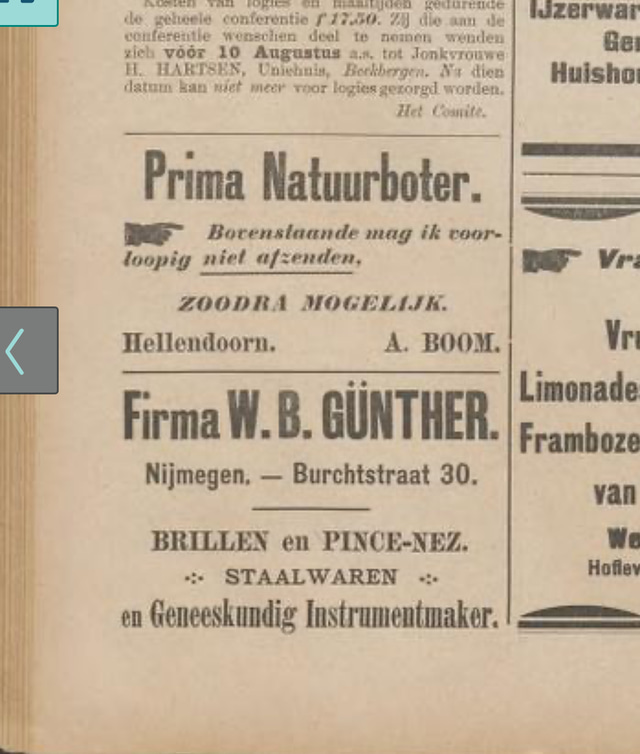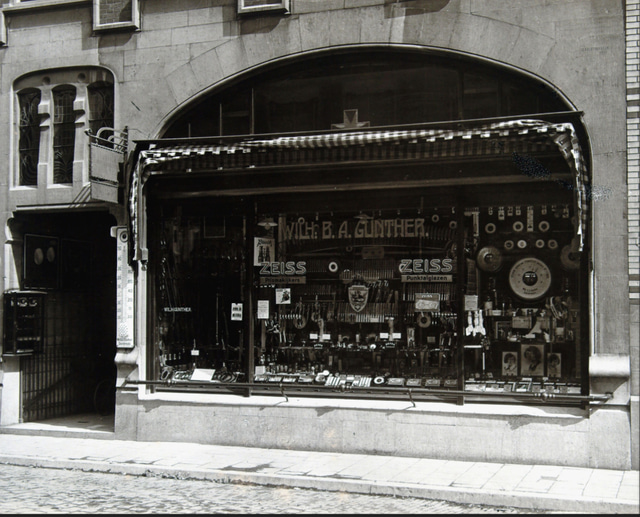

Biographical Information
Wilhelm Bernhard Günther was born in January 1820 in Erfurt (then Prussia, now Germany). His parents were Johann Friedrich Christian Bernhard Günther, who worked as a chancellor’s assistant, and Sophie Katharina Johanne Hedwig Schomburg. In April 1849, Wilhelm moved to Nijmegen, Netherlands, where on April 25, 1849, he married Johanna Hendrika Antonia Spriesterbach (b. 1818), a local resident. Günther settled in Nijmegen and established his own business. In official documents, his profession was recorded as instrumentmaker — a manufacturer of precision instruments.
Wilhelm Bernhard Günther passed away in Nijmegen on June 21, 1901, at the age of 81. By the time of his death, he was no longer professionally active. His wife, Johanna Spriesterbach, had passed away several years earlier, on February 7, 1887. The family archive preserved Günther’s last will and testament, written on December 16, 1886, at the office of notary J. Klaassen in Nijmegen, likely following the death of his wife.
The Workshop in Nijmegen
After moving to Nijmegen, Günther established a workshop and store on one of the city’s central streets. His address was Burchtstraat 30, located in the heart of Nijmegen. Günther was part of the local middle-class artisan community (“middenstand”), and his portrait photograph has been preserved in the city archive as part of a group photo from 1890, taken by Willem Ivens. This image is now kept in the Regional Archive of Nijmegen.
Günther’s shop in Nijmegen was highly regarded—local newspapers regularly recorded weather measurements there. Up until 1913, meteorological reports in newspapers indicated that barometric pressure readings were taken at “Firma W.B. Günther, Burchtstraat 30”.
For example, on July 12, 1913, the Provinciale Geldersche en Nijmeegsche Courant reported: “Barometer (noon: 760 mm, 4 PM: 761 mm); measurements taken at Firma W.B. Günther, Burchtstraat…”
This suggests that after Wilhelm Bernhard Günther’s death, his business continued under the same name, managed by his heirs.
Günther’s son, born in 1850, carried almost the same name as his father—Wilhelm Bernhard Antoon Günther. As a result, the firm’s name and initials remained unchanged.
Initially, the son was documented as a messenmaker (knife maker or blade craftsman), but later, he became known as an instrumentmaker en geweermaker — a precision instrument maker and gunsmith. The W.B. Günther company logo can even be found on swords from that period.
The Legacy of Firma W.B. Günther
After 1901, the store “Firma W.B. Günther” at Burchtstraat 30 remained in operation. As mentioned earlier, local newspapers continued referencing it as a meteorological station until World War I. Advertisements from the 1910s confirm that the company still offered optical instruments and tools.
However, the firm’s primary focus remained the manufacturing and sale of precision measuring instruments. Their shop sold mercury and aneroid barometers, thermometers, eyeglasses, optical devices, and steel tools.
A 1916 advertisement stated: “Firma W.B. Günther, Nijmegen – Burchtstraat 30. Brillen en Pince-nez. Staalwaren en Geneeskundig Instrumentmaker”,
which translates to: “Firma W.B. Günther, Nijmegen, Burchtstraat 30. Eyeglasses and Pince-nez. Steel goods and manufacturer of medical instruments.”
Thus, in addition to meteorological instruments, the company also traded in optics and metalwork.
It is also known that as early as 1889, the firm supplied innovations in optical devices. A Dutch medical journal mentions that W.B. Günther in Nijmegen offered a special “clip-on” monocle for cylindrical lenses. This highlights the company’s status as a universal manufacturer and retailer of scientific and household instruments in the 19th century.
Günther’s Barometers
Wilhelm Bernhard Günther was primarily known for his barometer craftsmanship. By the late 19th century, Europe saw the rise of advanced barometers, and Günther was among the first manufacturers in the Netherlands to produce them. He crafted both traditional mercury stick barometers and the newer aneroid barometers that were gaining popularity at the time.
His barometers were renowned for their exceptional craftsmanship, often featuring beautifully carved wooden cases.